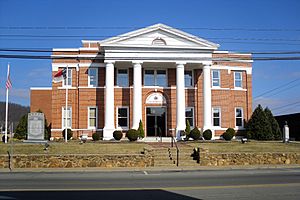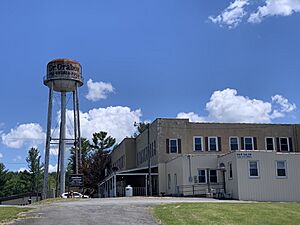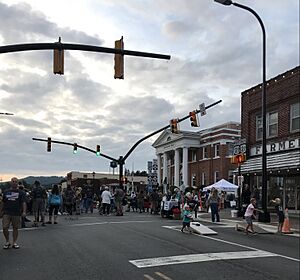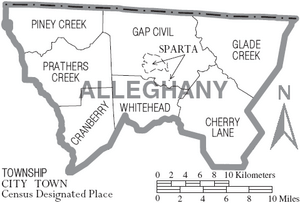Alleghany County, North Carolina facts for kids
Quick facts for kids
Alleghany County
|
|||
|---|---|---|---|

Alleghany County Courthouse
|
|||
|
|||

Location within the U.S. state of North Carolina
|
|||
 North Carolina's location within the U.S. |
|||
| Country | |||
| State | |||
| Founded | 1859 | ||
| Named for | Allegheny Mountains | ||
| Seat | Sparta | ||
| Largest community | Sparta | ||
| Area | |||
| • Total | 236.26 sq mi (611.9 km2) | ||
| • Land | 234.84 sq mi (608.2 km2) | ||
| • Water | 1.42 sq mi (3.7 km2) 0.60% | ||
| Population
(2020)
|
|||
| • Total | 10,888 | ||
| • Estimate
(2023)
|
11,342 | ||
| • Density | 46.36/sq mi (17.90/km2) | ||
| Time zone | UTC−5 (Eastern) | ||
| • Summer (DST) | UTC−4 (EDT) | ||
| Congressional district | 5th | ||
Alleghany County (/ˌælɪˈɡeɪni/ AL-ig-AY-nee) is a county in North Carolina, a state in the United States. In 2020, about 10,888 people lived here. The main town and county seat (where the county government is) is Sparta.
Contents
History
Long ago, the Cherokee and Shawnee Native American tribes lived in the area that is now Alleghany County. By the late 1700s, settlers from England, Germany, and Scotland-Ireland moved into the area.
Alleghany County was officially created in 1859. It was formed from the eastern part of Ashe County. A group of leaders chose a central spot to build a courthouse. This spot became the county seat, Sparta. Over time, the county's borders changed a few times.
In 1894, a businessman named Hugh Chatham helped start a vacation spot in Roaring Gap. This resort was later reorganized in 1925.
Growth and Industry
The building of the Blue Ridge Parkway in the 1930s brought more tourists to Alleghany County. This helped the county grow. In 1936, the Blue Ridge Electric Membership Corporation was started. This brought electricity to many homes and businesses.
In 1944, the first big factory, D&P Pipe Works, opened in Sparta. It moved from Chicago to be closer to local mountain laurel roots. These roots were used to make wooden tobacco pipes during World War II. At first, the factory used its own power generator because electricity was not always reliable. But after the war, power service got much better.
After World War II, Alleghany County's economy grew. More factories opened because land was cheaper and rules were simpler. Tourism also increased as more people built summer homes. Businesses like restaurants and shops opened along U.S. Route 21 for travelers. However, when Interstate 77 was finished in 1975, fewer people used Route 21.
The D&P Pipe Works factory, later called Dr. Grabow, once had about 350 employees. But as people became more aware of health concerns about smoking, the demand for pipes went down. Between 2000 and 2005, the county lost many of its factory jobs.
Geography
Alleghany County covers about 236 square miles. Most of this is land, and a small part is water. It is one of the smallest counties in North Carolina.
The county is in the northwestern part of North Carolina. It shares borders with other North Carolina counties: Surry, Wilkes, and Ashe. It also borders Grayson County in Virginia.
Alleghany County is entirely within the Appalachian Mountains. Most of the county is on a high, rolling plateau. This plateau is about 2,500 to 3,000 feet above sea level. The southern part of the county drops sharply by about 1,500 feet to the lower Foothills region. The highest point is Peach Bottom Mountain - Catherine Knob, which is 4,175 feet high.
The main rivers in Alleghany County are the New River and the Little River. The Little River flows through Sparta, the county seat.
Because it is surrounded by mountains, Alleghany County was sometimes called one of the "Lost Provinces" in the past. This was because it was hard to reach from other parts of North Carolina.
Climate
Alleghany County has cooler summers than lower areas nearby. Temperatures rarely go above 90°F (32°C). In winter, it can get very cold, with daytime highs sometimes in the teens or lower. It can also get a lot of snow. The average temperature is about 52.85°F (11.58°C).
Protected Areas
Alleghany County has several protected natural areas:
- Blue Ridge Parkway (part of it)
- Cumberland Knob Recreation Area (part of it)
- Doughton Recreation Area (part of it)
- Bullhead Mountain State Natural Area
- Mitchell River Game Land (part of it)
- New River State Park (part of it)
- Raven Knob Scout Reservation (part of it)
- Stone Mountain State Park (part of it)
- Thurmond Chatham Game Land (part of it)
Major Water Bodies
- Brush Creek
- Elk Creek
- Laurel Creek
- Lake Louise
- Little River
- New River
- Pine Swamp Creek
- Prather Creek
- Rock Creek
- South Fork New River
Major Highways
 US 21
US 21
 US 21 Truck
US 21 Truck US 221
US 221 NC 18
NC 18 NC 88
NC 88 NC 93
NC 93 NC 113
NC 113
Demographics
| Historical population | |||
|---|---|---|---|
| Census | Pop. | %± | |
| 1860 | 3,590 | — | |
| 1870 | 3,691 | 2.8% | |
| 1880 | 5,486 | 48.6% | |
| 1890 | 6,523 | 18.9% | |
| 1900 | 7,759 | 18.9% | |
| 1910 | 7,745 | −0.2% | |
| 1920 | 7,403 | −4.4% | |
| 1930 | 7,186 | −2.9% | |
| 1940 | 8,341 | 16.1% | |
| 1950 | 8,155 | −2.2% | |
| 1960 | 7,734 | −5.2% | |
| 1970 | 8,134 | 5.2% | |
| 1980 | 9,587 | 17.9% | |
| 1990 | 9,590 | 0.0% | |
| 2000 | 10,677 | 11.3% | |
| 2010 | 11,155 | 4.5% | |
| 2020 | 10,888 | −2.4% | |
| 2023 (est.) | 11,342 | 1.7% | |
| U.S. Decennial Census 1790–1960 1900–1990 1990–2000 2010 2020 |
|||
2020 Census Information
| Race | Number | Percentage |
|---|---|---|
| White (non-Hispanic) | 9,186 | 84.37% |
| Black or African American (non-Hispanic) | 103 | 0.95% |
| Native American | 35 | 0.32% |
| Asian | 15 | 0.14% |
| Pacific Islander | 6 | 0.06% |
| Other/Mixed | 255 | 2.34% |
| Hispanic or Latino | 1,288 | 11.83% |
In 2020, there were 10,888 people living in Alleghany County. There were 4,920 households, and 3,390 families.
Economy
Alleghany County is known for growing many Christmas trees. In 2022, about 1.2 million Christmas trees from the county were sold. The county also grows the most pumpkins in North Carolina.
The North Carolina Department of Commerce rated Alleghany as a Tier 2 county in 2023. This means its economy is somewhere in the middle, not the richest or the poorest.
Education
Wilkes Community College has a learning center in Sparta. In 2021, about 20.4 percent of people in the county had a college degree or higher education.
Healthcare
Alleghany County has one hospital, Alleghany Memorial Hospital, located in Sparta.
Culture
Sparta has a lively arts community. The town hosts "Music on Main" concerts every week from June to September. Local musicians perform for everyone to enjoy.
Communities
Town
- Sparta (This is the county seat and the largest community.)
Townships
Alleghany County is divided into these townships:
- Cherry Lane
- Cranberry
- Gap Civil
- Glade Creek
- Piney Creek
- Prathers Creek
- Whitehead
Unincorporated Communities
These are smaller communities that are not officially towns:
- Amelia
- Barrett
- Cherry Lane
- Edwards Crossroads
- Ennice
- Glade Valley
- Hare
- Laurel Springs
- Piney Creek
- Roaring Gap
- Scottville (partly in Ashe County)
- Stratford
- Twin Oaks
- Whitehead
Notable People
- Robert L. Doughton (1863–1954) was a United States Congressman from Alleghany County for many years. He helped create the Blue Ridge Parkway, which runs along the county's borders. A large park on the Parkway, Doughton Park, is named after him. He also played a big part in creating the Social Security Act.
- Rufus A. Doughton (1857–1946) was Robert Doughton's older brother. He was the Speaker of the North Carolina House of Representatives. He also served as Lieutenant Governor of North Carolina from 1893 to 1897.
- Bertie Dickens (1902–1994) was an old-time banjo player who lived most of her life in Ennice, North Carolina. She won the North Carolina Heritage Award in 1992 for her music.
- Zach Galifianakis (born 1969) is a famous comedian and actor. He lives on a farm near Sparta and spends his time between the farm and his work.
- Del Reeves (1932–2007) was a country music singer. He became a member of the Grand Ole Opry in 1966. His song "Girl on the Billboard" sold over a million copies.
See also
 In Spanish: Condado de Alleghany (Carolina del Norte) para niños
In Spanish: Condado de Alleghany (Carolina del Norte) para niños







